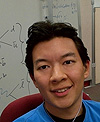Paving the way: first student from a Philippine university at Fermilab
 |
|
Michael Andrews
|
If you're a student who wants to pursue the field of high-energy physics, your usual path is to attend a university whose wagon is hitched to one of the world's particle physics laboratories. From there you get the chance to work on an experiment.
Michael Andrews, a physics graduate student from the Philippines, had no such wagon before he came to Fermilab in June. His school, Ateneo de Manila University, has no official connection to a particle physics laboratory. So he formed his own connections, and now he is the first student from a Philippine university to have worked at Fermilab.
"He's playing a special role, paving the way for future collaborations between Philippine universities and Fermilab," said his Fermilab advisor Michael Wang of the Scientific Computing Division.
The Philippines has little in the way of high-energy physics programs. The nation's state university, the University of the Philippines, sends students to CERN on occasion. Although it has particle theorists and phenomenologists on its faculty, it has no experimentalists. To gain a foothold in high-energy physics experiment, Andrews had to strike out on his own.
In January 2012, Andrews attended a workshop in Singapore co-hosted by CERN. The only Filipino at the meeting, Andrews approached a CERN experimentalist about opportunities to work on particle physics. Through him he eventually connected with fellow countryman and UP alumnus Michael Wang, who later worked on DZero.
Wang replied to Andrews' inquiry, offering him an opportunity to work on DZero top quark analysis, facilitated by the DZero spokespersons and the laboratory directorate.
"What really caught my excitement was that there was a real opportunity for me to come here and do analysis," Andrews said. "I was not expecting to fly anywhere. I was just expecting to work with someone in the local universities on some small project."
Andrews arrived at Fermilab in June. Analyzing particle collision data was new to him, so the first month was a brute-force education in collision analysis. He got through it with the help of Wang and several DZero doctoral students and postdocs.
"Michael set up all the analysis tools, derived all the corrections that need to be applied to the data," Wang said. "He's brought the analysis to a stage where all you have to do is apply the corrections to data, and that's the easy part."
Andrews completed his Fermilab residency earlier this month and will continue to work on the DZero analysis for the master's thesis he will complete this year. He also plans to publish a paper on this work and is currently applying to doctoral physics programs in the United States.
"At a science lab, everybody in the research arena is dedicated and really has the drive to do things correctly, precisely," Andrews said. "It's been exciting to be part of it."
—Leah Hesla
|